Mechanically the car was really an evolution of the Uno, with similar solutions being applied to most areas, the one major new development was the
rear suspension,
which followed the independent layout of the Tipo.
The engines were basically the same as in other models, though improved
in numerous minor details. These comprised 1108cc FIRE (54bhp), 1242cc
FIRE (58bhp with single-point fuel injection or 73bhp with multi-point
fuel injection), 1581cc sohc (88bhp), 1372cc turbo (136bhp) and 1698cc
diesels (71bhp turbocharged and from 1994 57bhp normally aspirated) units.
Corrosion protection was another area of the new Punto which saw many steps forward from the Uno. Over 60% (by weight) of the bodyshell is galvanised,
the majority on both sides, including 90% of the exterior surface. Long and severe testing was designed to finally change the poor reputation some Italian
cars had in this area.
Apart from the standard models there was
also the 'Selecta', fitted with a CVT, using the 1242cc unit (in this application
with 60bhp) and the Cabrio. The latter was designed by Giugiaro and built
by Bertone. Available with either the 1242cc or 1581cc engine, it featured
a reinforced structure, including an anti-roll bar built into the windscreen pillars.
1997 saw the replacement of the 1581cc
engine in both the Sporting and the Cabriolet by a 1242cc 16V FIRE engine
with 86bhp. Numerous other changes were made to most models, including power steering, air conditioning, new interior trims and external colours,
revised suspension settings, improved soundproofing, new wheels and various detail modications. Production stopped in 1999 when it was replaced by the nuova
Punto.
The 1994 Turin Motorshow saw a series of concepts
based on the Punto by Bertone, Boneschi, Coggiola, Giannini, Idea, Italdesign, Maggiora, Pininfarina and Zagato. See our 'Concept Cars' page
for images of some of the other concept cars based on the Punto.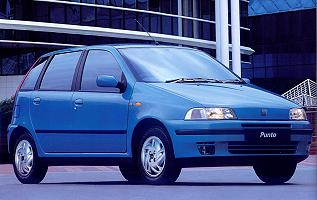 The Fiat Punto was presented in November 1993 to replace the Uno.
Giugiaro designed two bodystyles for Fiat, a three door and a five door hatchback (the Cabrio came later), and its fresh design contributed to it being
voted European Car of the Year in 1995. It was also aerodynamically very efficient, with a drag factor of just 0.31. A completely new car, significant improvements were made over the old Uno in many areas, in terms of functionality
the much praised class-leading interior space was one of the most important.
The Fiat Punto was presented in November 1993 to replace the Uno.
Giugiaro designed two bodystyles for Fiat, a three door and a five door hatchback (the Cabrio came later), and its fresh design contributed to it being
voted European Car of the Year in 1995. It was also aerodynamically very efficient, with a drag factor of just 0.31. A completely new car, significant improvements were made over the old Uno in many areas, in terms of functionality
the much praised class-leading interior space was one of the most important.
In terms of safety, the new Punto featured a
structure
designed to meet much more stringent crash tests including side impact protection, dual front airbags
(optional on some models), various fire protection systems such as a fuel cut-off valve, anti-submarining seats, seatbelt pretensioners, energy absorbing
steering wheel and of course ABS (optional on some models).
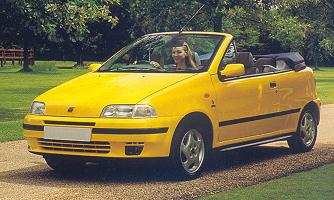 To produce the Punto Fiat built a new, highly automated and fully integrated factory near Naples in the south of Italy, at Melfi.
With a large number of major suppliers colocated, it was one of the most efficient car factories in Europe at the time of its construction.
The Punto was also produced in smaller numbers at Mirafiori and Termini Imerese in Sicily.
To produce the Punto Fiat built a new, highly automated and fully integrated factory near Naples in the south of Italy, at Melfi.
With a large number of major suppliers colocated, it was one of the most efficient car factories in Europe at the time of its construction.
The Punto was also produced in smaller numbers at Mirafiori and Termini Imerese in Sicily.
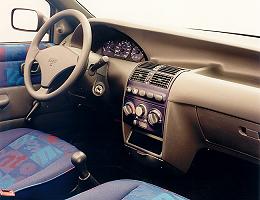 Shortly after the initial launch, in May 1995, the Punto Sporting was released. This also used
the 1581cc unit, but with lower gearing. Some extra body trim, alloy wheels,
internal trim changes and suspension changes similar to those used on the
GT (1372cc turbo) model were also applied, the result being a car with heightened driver appeal.
Shortly after the initial launch, in May 1995, the Punto Sporting was released. This also used
the 1581cc unit, but with lower gearing. Some extra body trim, alloy wheels,
internal trim changes and suspension changes similar to those used on the
GT (1372cc turbo) model were also applied, the result being a car with heightened driver appeal.
Technical Details
| Driveline | transverse engine at front with front wheel drive |
| Suspension | front
: MacPherson strut with telescopic dampers and coil springs (plus anti-roll bar on some models)
rear : independent with trailing arms, coil springs and telescopic dampers plus anti-roll bar wheelbase : 2450mm track (front/rear) : 1369mm/1352mm (Sporting & GT : 1380mm/1352mm) |
| Brakes | front : discs (240mm or 257mm diameter)
rear : drums (180mm diameter) (240mm diameter discs on GT) handbrake operating on the rear via a cable ABS (Lucas 4 channel) optional/standard on some models |
| Gearbox | 5 speed manual or 6-speed manual
ECVT (automatic electronic continuously variable transmission) |
| Steering | rack and pinion (with power assistance on some models) |
| Empty weight | 55 : 3-door SX : 850kg, 5-door SX : 875kg
60 : 3-door S : 865kg, 5-door Selecta : 965kg Sporting : 975kg Cabrio : 60 : 960kg, 90 : 1070kg Diesel 3-door : 1445kg, TD 5-door : 1500kg GT : 1000kg |
Click here for a diagram of the Punto structure.
Tuning
There are three main areas to concentrate on, the engine (and transmission), the brakes and the suspension and then various other details. These three should be done together since they complement each other, not all of one and none of another !
1. The engine.
Before modifying the engine it is worthwhile
filling it with a good quality synthetic oil and fitting new spark plugs.
An engine oil additive may also be used.
The first improvements are relatively simple.
The air filter can be replaced for an aftermarket item which will help
the engine breathe more freely, the type which completely replace the orignal
air box are best, and the exhaust can be replaced for one which will restrict
the exit of the gases less. The whole system should be replaced, not just the rear section.
The most effective modification (short
of engine rebuilds!) is probably to replace the electronic control unit
(or 'chip'). A variety of these are available, but all should increase
the power and improve the driveability. The downside is that these usually
cancel the warranty and may affect the durability of the engine, the emissions and the fuel consumption.
Further modifications require the machining
of the cylinder headand/or cylinder block (which will not be dealt with
here since it is not normally a DIY job) after which it may be worth fitting
an oil cooler. If overheating is a problem due to the increased power output
then a small hole can also be drilled through the plate in the thermostat.
Regarding the transmission the main requirement
is to uprate the clutch to handle the increase in power and torque achieved
though the engine modifications. Friction plates can be purchased with
improved materials and heavier duty pressure plates are also available.
Whilst doing this it is worthwhile lightening the flywheel.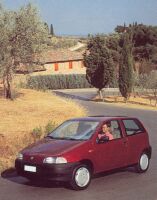 Other
things to do should include fitting a cold air intake, a large diameter
pipe (minimum 5cm) to provide air from outside the engine bay to the air
filter. The exhaust manifold can also be lagged with thermal cloth or tape
to keep the exhaust gases hotter (and thus reduce back pressure) and also
to keep the underbonnet (and hence intake and fuel) temperatures lower.
Other
things to do should include fitting a cold air intake, a large diameter
pipe (minimum 5cm) to provide air from outside the engine bay to the air
filter. The exhaust manifold can also be lagged with thermal cloth or tape
to keep the exhaust gases hotter (and thus reduce back pressure) and also
to keep the underbonnet (and hence intake and fuel) temperatures lower.
The high tension leads can also be replaced with performance ones.
2. The brakes.
Initially it is relatively easy to replace
the brake discs with drilled and grooved items, and the pads for a harder
compound. The latter should not be too hard (ie no race pads on the road)
or they will not function efectively at the normal 'road' operating temperatures.
Stainless steel braided flexible hoses will improve the pedal feel and
reduce the chance of damage whilst DoT5 fluid (not silicon) will increase
the temperature at which it can operate effectively. If the brakes are
gettng too hot the dustguards can be removed and/or ducts fitted, taking
air from behind the front bumper.
If more serious braking is required the
next modification would be to increase the disc size. It is possible to
use larger discs with a In order to improve the balance of the
car under braking it is desireable to be able to adjust the balance of
braking from front to rear (and vice versa). This can be accomplished by
fitting a bias valve in the line to the rear brakes, usually in a position
so that it can be reached from the drivers seat.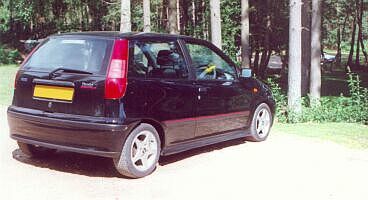 bracket
allowing use of the production callipers, or alloy four pot callipers can be fitted.
bracket
allowing use of the production callipers, or alloy four pot callipers can be fitted.
3. The suspension.
The easiest improvement,and the one which
will probably bring the single most noticeable change, is to replace the
full set of dampers and springs. A variety of kits are available which
include four matched dampers and springs. Top adjustable units are compromised,
but are good for road and track day cars since it allows the suspension
to be adjusted between these two, rather different, requirements. Coil
over units add more adjustability and can be purchased outright, or can
be made from standard dampers by welding a threaded sleeve to the standard tube.
There are then two other main suspension
aims; to reduce the flexiblity in the suspension and to increase the stiffness
Into this category also fall the choice
of wheels and tyres. With an increase in power it can be necessary to fit
larger tyres (thus requiring larger wheels) but the temptation to fit the
biggest possible should be resisted. Consideration should be given to fitting
a wider tyre on the front (since they provide traction and steering) but
keeping the standard, or a wider but not as wide as the front, tyre at
the rear. This will improve the balance of the car.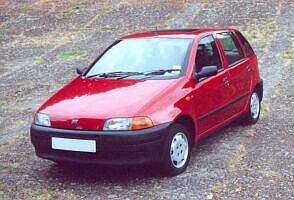 of the car, both of which aim at more accurate control of the wheel movement.
To reduce the flexibility it is possible to fit nylon bushes instead of
the normal production rubber items, or if perfection is desired the suspension
can be fitted with metallic bearings (rose joints / rod ends).
Spherical bearing top mounts can also be used. To stiffen the car it is
most popular to fit strut braces. These can be fitted to the front and
rear. For more extreme cases a rollcage can be fitted.....
of the car, both of which aim at more accurate control of the wheel movement.
To reduce the flexibility it is possible to fit nylon bushes instead of
the normal production rubber items, or if perfection is desired the suspension
can be fitted with metallic bearings (rose joints / rod ends).
Spherical bearing top mounts can also be used. To stiffen the car it is
most popular to fit strut braces. These can be fitted to the front and
rear. For more extreme cases a rollcage can be fitted.....
4. other things.
Other modifications worth considering include fitment of a shift light (and rev limiter if there is not one as standard), higher power bulbs in the headlights (if you are going to go faster you need to see further) and installation of a quicker steering rack.
Buying / Selling
Some tips to do before selling :
(they may seem obvious, but most people don't do them and thus are in a
weaker bargaining position).
Tidy inside the car thoroughly : hoover
the floor, empty all pockets, ashtrays (wash), glove compartment etc...,
wipe the trim with a damp cloth, give the cockpit a good airing to get
rid of any odours ! Reset the trip meter to 00000 - it is a pleasant (subconcious) surprise.
If the car has been standing give it a
good run - this will clear out the engine (reduce exhaust smoke), put a
shine on the brake discs and loosen up any joints that may otherwise make some noises.
'Back to black' products are very effective
at temporarily restoring bumpers and trim. This makes a big difference
to any car. Do it a week before you expect people to view the car, otherwise
it may be a bit too obvious !
Jetwash under the car, especially under
the engine and in the wheelarches. The prospective buyer may be an enthusiast,
and this makes it easier for them to see what they want to check.
Obviously wash the car and clean the windows !
If you are going to buy a car always check the following :
Firstly check the bodywork. Check that
there are no mismatching panels, large areas of discolouration or signs
of fresh paint (compare inside the engine bay with the external body colour),
all of which probably indicate accident damage. No need to worry about
rust, by the Punto this was long a thing of the past with Fiats.
Check the main electrical functions - wipers,
windows, lights, etc... try putting the main beam and wipers on at the
same time. Check the headlights for cracks.
The engine should be run up to temperature,
check the exhaust for smoke, the condition of the breather (look for mayonnaise),
the condition of the oil filler cap (again white deposits can indicate head
gasket or other serious problems or the use of the car only on short journeys,
another bad state of affairs) and the colour of the coolant (preferably
not thick or dark brown!). Listen to the noise of the engine, then depress
the clutch and engage first gear. Whatever noise has disappeared was coming
form the gearbox, what remains is from the engine. Also check the condition
of the engine oil on the dipstick. The lighter brown the better, if it is
thick black then leave quickly.
Check tyre wear, uneven patterns could imply a bent chassis.
Always take it for a test drive. Check
that the car tracks in a straight line with no steering input and also
remains straight under braking. Find a large open area and complete several
lock to lock turns (also in reverse), listening for any noises. Try the
handbrake when moving - seized rear callipers will mean uneven braking or no braking.
Check the transmission of Selecta models
(the CVT version) carefully for any jerking when selecting and pulling
away and for creep at idle.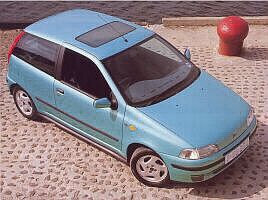 Check
the brake pedal does not go to the floor if pressed hard for a long time
and check the gearchange for clean engagement.
Check
the brake pedal does not go to the floor if pressed hard for a long time
and check the gearchange for clean engagement.
Links
A Fiat Punto GT website
Fiat Punto Workshop Manual :
buy
it online here (in association with
Amazon)
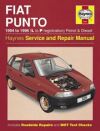 Fiat
Punto Service and Repair Manual Fiat
Punto Service and Repair Manual |
Haynes, 1999 |
For more books on Fiats, see our Online Bookstore
Punto comment form
Your Comments
Having driven a Punto for
a short while through work I would say that for a smaller car it handles
well, is economical and is a fun drive ! Overall great !! (Helena)
I'm on my second Punto, a '98 85ELX 16v after a 75SX, both from new. They're the best small
cars I've ever owned, and the 16v engine spins freely and powerfully all
The Punto is one of the best
car of mid size ever built, and your engine since the basic of 60 cv to
the turbo of 136cv made of it the one of your category. Its sadly that
in my country Chile the dealers don't sell it anymore and change it for
a less and mediocre model like the Palio. (Jose M, Chile)
Just bought a 1998 red 75SX
and its by far the best car I've owned having had a Fiesta, a Renault 5
and a Seat Ibiza (old style system porsche) :o) Revvy little car Love it it :o) (M.K, Scotland)
Have been driving a Punto
Selecta for a year. They say the best things come in small packages and
what a package this little car is. CVTs may have their own quirks which
take getting used to but they bring a level of smoothness that is hard to find in a small car. (Andy)
I have had various performance fiats in the past and several non performance models too and nothing beats
Italian engineering for style and performance. I own a punto gt at present and will soon be changing for a Lancia Delta Integrale
Evoluzione 2 but what fond memories I will have of the "pocket rocket". (Sandy H, Scotland)
My dad owned two puntos a 75sx and a 60sx. Both were utterly reliable startinfg first time every time, the 75 needed only a new indicator
during the 3 years the 60 needed only a brake build during four years. Both were serviced once a year by fiat. Parking without power steering is
vague. Steering is generally good but there is slight wander at high speed. The body work resists rusts and is much better built than the tipo.
the best! At 188000 km I had no problem!!!!!!!!!!!!
We have used Punto's in our driving school here in the UK, and very happy with them
I have driven lots of cars but I have kept to the Punto now for over two years and I find that it is a very reliable and economical vehicle and I would only change it for another Punto.
A great car to drive and own ! (Andy W, UK)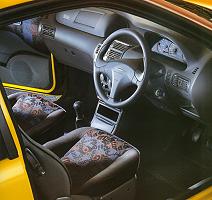 the way to 6.5K. I'm not impressed with the styling of the nuovo Punto,
so will be looking elsewhere next year, plus the Fiat Dealer network leaves
a lot to be desired. But it's a terrific car, great value, loads of space
and goes like the clappers in thrash mode! (John, UK)
the way to 6.5K. I'm not impressed with the styling of the nuovo Punto,
so will be looking elsewhere next year, plus the Fiat Dealer network leaves
a lot to be desired. But it's a terrific car, great value, loads of space
and goes like the clappers in thrash mode! (John, UK)
There is also a list of all our picture galleries (including museums, motorshows and various events).
Wallpapers/Desktop Backgrounds of numerous Fiats also available to download.
Copyright © 2000 to 2011 CarsfromItaly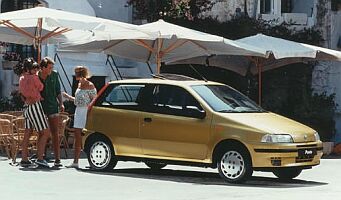 Use
the buttons at the top to navigate further, or
Use
the buttons at the top to navigate further, or